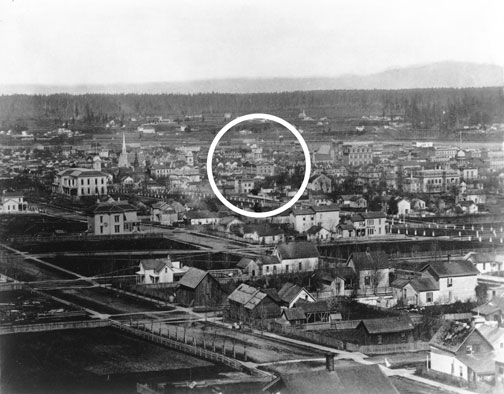the PIONEER
COURTHOUSE
building
Pioneer Courthouse is
the second-oldest federal
courthouse west of the
Mississippi River.
Judge Matthew Paul Deady, the Oregon Territory's pre-eminent jurist and subsequently Oregon's first federal judge, requested in the early 1860s that the federal district court be moved from Salem to Portland, thereby initiating the effort to make Portland its home.
Completed in 1875, Pioneer Courthouse has remained at the city's geographic and commercial center.
The property on which it stands was part of the land purchased in 1848 by Daniel Lownsdale from Francis Pettygrove and Asa Lovejoy, the founders of Portland. (Lownsdale paid in leather valued at $5,000). Lownsdale, who gave Portland the land on which the Park Blocks lie today, dedicated the Pioneer Courthouse's block to the city for a public market. Ownership of the land went through a series of legal challenges with the City ultimately prevailing and in 1869 Portland sold the block to the United States government for $15,000.
During the 1850s-60s, the City of Portland had fewer than 10,000 residents. Streets were often troughs of mud with tree stumps within sight of the soon-to-be courthouse grounds. The city hugged the west bank of the Willamette River, the five blocks between here and the river barely filled with rough houses and small fields. When the courthouse was first proposed, complaints that it was too far out-of-town were heard on many street corners, that the Pony Express would be needed just to mail a letter!

The photo above is Pioneer Courthouse
Construction on the Pioneer Courthouse began in 1869. The courthouse was formally opened and dedicated when it was completed six years later. The West Shore Magazine (a precursor to today's Sunset magazine) began publication in 1875 and, in its first issue, featured the new courthouse and post office building:
“...The imposing structure of beautiful blue freestone, the conspicuous situation, the solid and substantial character of the work, the neat style of its architecture, and the taste and perfection of its construction from foundation to dome, at once attract admiration....
The fine and beautiful freestone of which the edifice is constructed was taken from quarries near Bellingham Bay and Tenino...each stone when taken from the quarry having been designated for a particular position in the grand work of construction....The woodwork is nearly all of the best of Oregon ash....After ascending a double flight of steps, to the second story, we come upon the Court Room...displaying the same superb taste in arrangement peculiar to the whole work.
Passing on to the third story, through various offices and rooms, we again ascend another flight of steps, and find ourselves in a spacious cupola, affording a beautiful bird's-eye view of our young and thriving city.”

